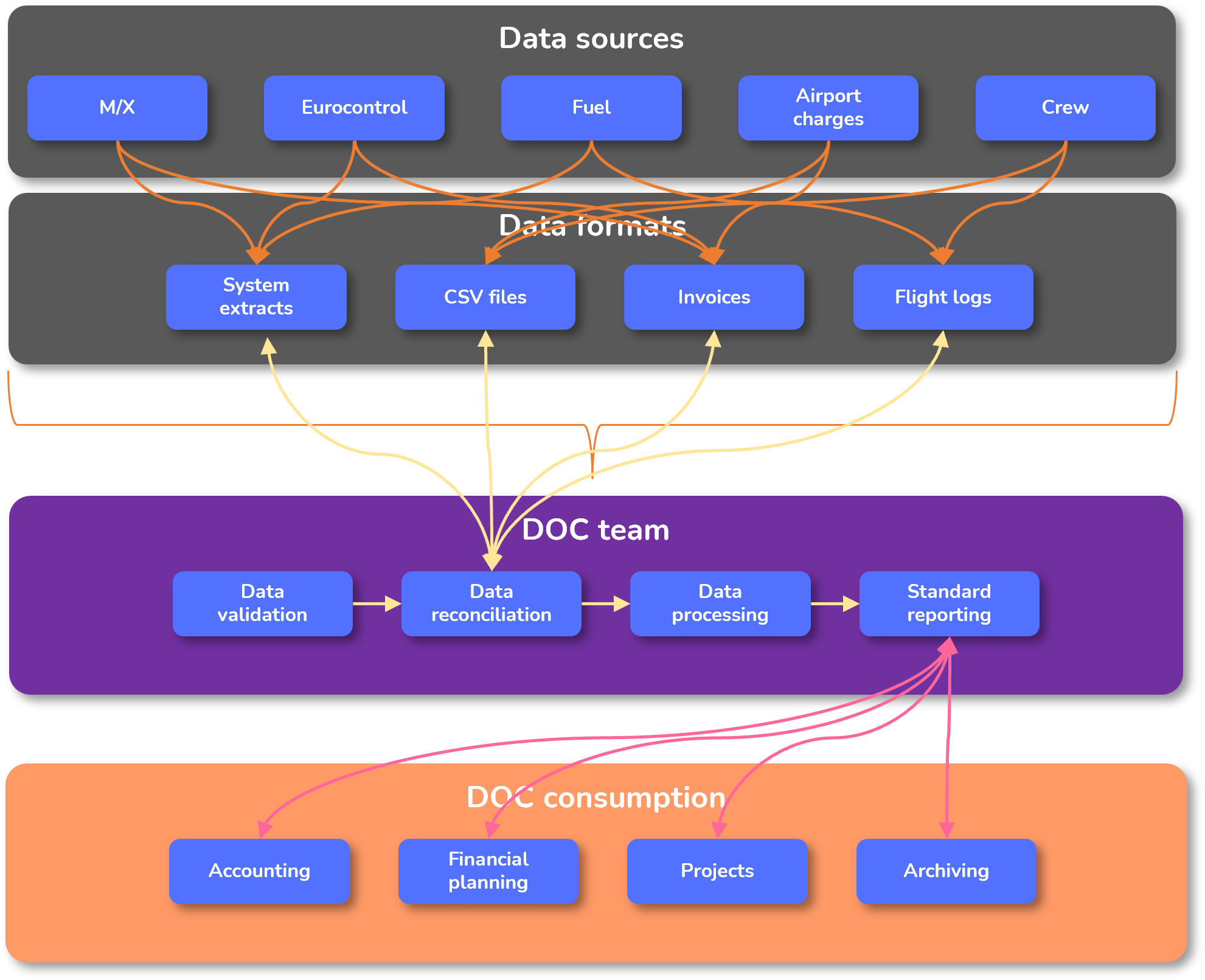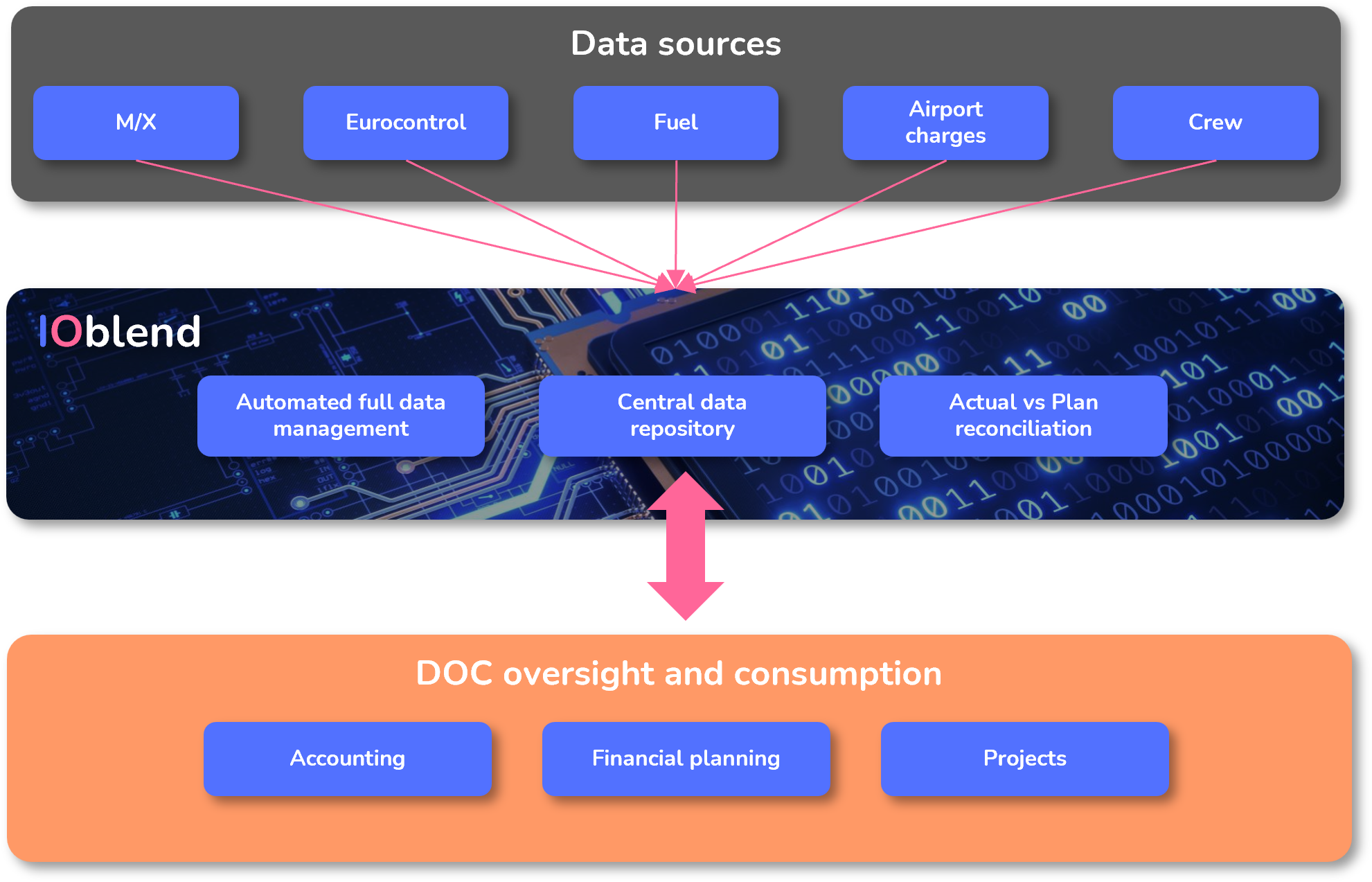Data drives modern airline business. Manual and legacy data management practices strangle it.
You are getting a taste of what is possible with data from your analytics dashboards. You’re starting to see where efficiencies can be made, new revenue opportunities unlocked. All the possibilities! The world of the future is truly bight.
But then you realise that to get there will take you an enormous effort and cost a fortune. Just that one dashboard you rely on weekly (monthly) has been put together by a platoon of analysts, sweating to the last minute to ensure the data is of the right quality and stitched up together properly. Tedious, unrewarding work for them and a waste of resources for your company.
Plus, if you want to act on the findings – say, automating route charges data processing can save £200K pa in lost time and enable faster decisioning – you can’t. Your IT infra has been setup decades ago and all the decision-making processes are manual. Forget real time decisions. Your drive a “super tanker” that takes months to change direction.
So, you just carry on as you were, while the more agile competitors take advantage of your inefficiencies.
Luckily, there are now ways to have your cake and eat it. Companies like ours are hard at work to bring you into the modern times without needing to spend a fortune.
Previously, we covered how airlines could improve their fuel data management with IOblend. In this article we continue our series of practical examples on how IOblend helps to automate other data management processes, so that your business can focus on value-add activities fast and cost-effectively.
Let’s look at how an airline’s operating cost data is collated and curated – also known as DOC, or Direct Operating Cost.
Management of the DOCs is a crucial process but resource consuming, prone to errors and requires skilled finance people (often with specialist experience) due to the complexity and lack of automation and standardisation of the DOC process.
Process as is (some airline specific variations may apply):

DOCs comprise of several operating cost line items, including but not limited to: fuel, ground handling, crew, maintenance, enroute charges, overflight charges, airport charges, etc.
The data comes in various forms and from multiple sources that needs to be validated and collated: aircraft systems, invoices, airports, HR logs, MX logs, Eurocontrol invoices, NATS, etc
A dedicated DOC team manually processes this data as it arrives in periodic batches and varying formats. Normally, you would have responsible analysts for recording each cost line.
The processed data is then reviewed by the DOC manager before it gets loaded into a Cube or other data management systems. This takes place as a batch job, often in an overnight load. Data engineers manage this process.
Once in the Cube, the data is accessed by the central finance and accounting teams for further cross-checking against Plan, reporting, and ad hoc analysis. If any inconsistencies are found, it takes hours/days/weeks to track down.
There is no automation in any of this data flow, no clear way of error-tracking, and no automatic decisioning.
This process is very laborious, tedious and time-consuming. It involves talented finance and IT experts, whose skills would be much better utilised when driving real value through deep insights and acting fast on those findings. In the airline world of extremely tight margins, such an approach could make the world of difference.
IOblend can be easily applied to managing airline’s DOCs, by shifting the burden of manually collating various data inputs, processing them, and comparing against Plan to an automated system and greatly reduce resource usage and errors
Process using IOblend:

IOblend extracts and processes data automatically regardless of the source.
The SMEs apply the desired business logic with SQL when setting up the process initially (or amending later for new insights).
The software then automatically processes all relevant data in memory, validates and reconciles it against Plan and makes it available for immediate consumption by the relevant systems and departments. This process can happen in batches, real time, or a combination of the two, all automatically. The data (and associated metadata, schemas, business logic, ownership, time stamps, etc) is also stored in a repository (yes, you can still use your legacy data warehouse for this if you don’t have a Cloud).
If any of the source of destination systems go down, IOblend will go back as far as needed and recover any lost data. It will also update all the associated computations throughout the process.
SMEs only get involved by exception. When the data errors fall outside of the specified parameters, they get alerted and directed to the exact causes of the issues, so those can be resolved quickly.
The entire process is fully automated, robust and cost-effective. Minimal maintenance is required (we have clients who never touched it). It runs entirely in within your security protocols, meaning no data ever leaves your environment. Full peace of mind.
And the best part is your business now has the full freedom to work with the DOC data on demand. You can automate decisioning – e.g. if a requested fuel uplift significantly varies from Plan, record the event with location, flight number, crew ID, time, etc., and send an immediate notification to the Flight Ops.
At IOblend, we have built the next generation, no-code data solution to easily streamline your current data estates and unlock new capabilities to make or save money. We are ex-airline folks ourselves and we know your pain points well. We also know your budgets are tight. We want to help you to take advantage of your data fast and without breaking the bank. Don’t fear change.
Start small, get the value one place at a time and scale from there. With the scalable underlying solution that is platform-agnostic, you can take advantage of using any tech that best suits your business – mix and match at will.
If we spiked your interest, get in touch. Let’s discuss how we can help you make the most of your data.

Data Strategy: Taking a Business View
Data strategy aligns data-related activities with the strategic goals of an organisation. It’s about turning data into value.

Out with the Old ETL: Navigating the Upgrade Maze
Today, we have tools and experience to make digital transformation easy. Yet, most organisations cling to their antiquated data systems and analytics. Why?

Smart Data Integration: More $ for Your D&A Budget
Data integration is the heart of data engineering. The process is inherently complex and consumes the most of your D&A budget.

Data Pipelines: From Raw Data to Real Results
The primary purpose of data pipelines is to enable a smooth, automated flow of data. Data pipelines are at the core of informed decision-making.

Golden Record: Finding the Single Truth Source
A golden record of data is a consolidated dataset that serves as a single source of truth for all business data about a customer, employee, or product.

Penny-wise: Strategies for surviving budget cuts
Weathering budget cuts, particularly in the realm of data projects, require a combination of resilience, strategic thinking, and a willingness to adapt.

